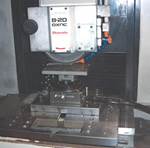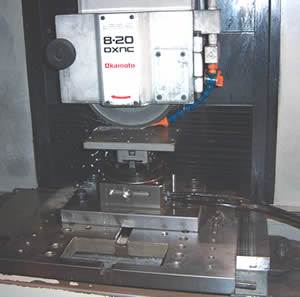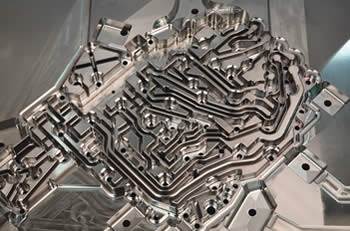Jig Grinding, EDM or High-Speed Milling?
When evaluating new processes for mold manufacture, jig grinding is worth a second look as machine manufacturers have now added high accuracy features to guarantee repeatable results.
As the challenges continue to arise—such as wall thickness of the finished molded product becoming thinner and thinner—jig grinding is delivering the required higher accuracy and repeatability to molds. Mold closures must be perfect with no mismatches, and manufacturers no longer tolerate inferior quality associated with their products. In the final analysis, the required accuracy found in molds today can only be achieved on a consistent basis by using a jig grinding machine.
By examining the advantages, limitations, features and applications jig grinding has compared to EDM and high-speed milling, you will arm yourself with the information you need to make the right decision when it comes to purchasing your next machine tool.
EDM
Once accepted as the favored solution, jig grinding faced strict challenges from the developing technology known as EDM. From the early introduction of EDM as a mold manufacturing process in the 1980s, EDM became one of the most popular methods for meeting moldmaking demands. The advantages—primarily centered on cost and speed—of EDM outweighed the benefits of jig grinding, and practically every shop associated with moldmaking rushed to investigate and eventually equip their shops with this new technology.
The driving force behind the rush was the hope of being able to eliminate what was at the time viewed as costly jig grinding operations. The price and performance parameters that jig grinding represented to the market were considered costly for several reasons:
- Heavy initial capital investment
- Setups and changeovers were labor intensive
- Lack of knowledgeable operators: designers and manufacturing engineers who understood the specialized applications and grinding technology used in jig grinding operations were difficult to employ.
The downside of using EDM was, of course, surface finish results, size control and profile tolerance. Jig grinding provides excellent surface finish results and tolerances in the 1 to 2 micron range for profile accuracy.
In addition, jig grinding is significantly faster than previously achieved on competitive machines, due to specialized software and hardware characteristics that take advantage of the simple-to-use software.
High-Speed Milling
Today, high-speed milling is being compared to jig grinding as an alternative process. As in the past, the complaints associated with the costs of jig grinding—centered on capital equipment costs and labor issues—forged the way for the new hard milling process into the world of mold manufacturer.
While planning for expansion and looking to improve operations as the economy improved, many mold manufacturers’ applications involved high quality molds, and hard milling simply couldn’t deliver on tolerances and surface finishes.
In many instances, nothing could be found to completely replace jig grinding operations. With the realization that jig grinding was a necessary process, thoughts of combining the two processes seem to have evolved as the best practice for high quality mold manufacturing.
Jig Grinding
As previously mentioned, jig grinding is significantly faster today because of specialized software and hardware characteristics.
Specialized software refers to those macros that minimize the operators input in calculating intricate geometries and reduce or eliminate manual data input. Beginning and ending points for cutting using simultaneous rotary, oscillating and orbital start/stop points are macro driven, reducing setup and changeover.
Special hardware refers to periphery equipment that measures the grinding wheels after each wheel dressing to ensure sub-micron positioning and grinding. Scraped guideways used in conjunction with linear bearing guideways provide rigidity, and smooth and consistent dampening points, allowing for precise reversal points. Accurate reversal points and repeatability permit high-speed grinding without the worry of “bumping” or bottoming out in blind holes.
The electro-mechanical package together with the specially developed software is optimized, which gives the operators the ability to take advantage of the high speeds and feedrates not typically associated with earlier generation jig grinding machines.
In an effort to fortify the jig grinding markets, builders had to address the price performance issues associated with jig grinding, and to offset the level of operator skill required to run jig grinding machines. Through the use of increasingly more powerful CNC controllers, jig grinding routines are now automated.
Geometric calculations and the subsequent “hard tooling” settings that were previously needed to achieve various grinding requirements are now included in macros built specifically for jig grinding. This of course makes changeovers easier and faster while strengthening the grinding cycles by removing wasted movements.
Technical improvements (many patented) were incorporated into jig grinding platforms making jig grinding equally—and at times more—efficient than many high-speed milling or EDM processes for moldmaking applications. Mechanical improvements coupled with hand-scraped guideways have improved solid incremental movements and stiffness—allowing for faster and heavier cuts.
A modern jig grinder today is equipped with features making the machine extremely fast and easy-to-handle. The programming has been simplified today with the pre-defined grinding cycles available to the operator. Automation (ATC and pallet changers) also is helping the machine to work unattended, just as an EDM or high-speed milling machine. The grinding process can be monitored via the integrated MSS measuring system assuring the highest accuracy in unattended operation.
Summary
Today, machine tool manufacturers are capable of delivering machines where the efficiency has doubled in comparison to standard jig grinding machines, and still maintaining the highest accuracy. Investing in this type of machine might very well be the smartest way to stay ahead of the competition.
Related Content
It Starts With the Part: A Plastic Part Checklist Ensures Good Mold Design
All successful mold build projects start with examining the part to be molded to ensure it is moldable and will meet the customers' production objectives.
Read MoreRevisiting Some Hot Runner Fundamentals
What exactly does a hot runner do? If you’ve been in the injection molding industry for any length of time, you might think the answer is obvious, but it is not.
Read MoreHands-on Workshop Teaches Mold Maintenance Process
Intensive workshop teaches the process of mold maintenance to help put an end to the firefighting culture of many toolrooms.
Read MoreHow to Eliminate Chatter
Here are techniques commonly used to combat chatter and guidelines to establish a foundation for optimizing the moldmaking process.
Read MoreRead Next
CNC Grinders Decrease Manpower, Improve Delivery Times
Switching from manual to CNC grinders results in leadtime, programming, accuracy and tolerance benefits for this moldmaker.
Read MoreHigh-Speed Machines Deliver Speed, Accuracy, Repeatability and Finish
The addition of high-speed machines that blend a reasonable cost with high performance helps one moldmaker realize a huge competitive advantage.
Read MoreHow to Use Continuing Education to Remain Competitive in Moldmaking
Continued training helps moldmakers make tooling decisions and properly use the latest cutting tool to efficiently machine high-quality molds.
Read More





















